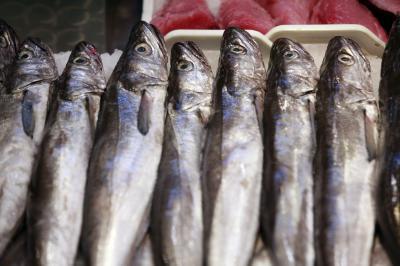What is most important when buying fish: the price, the country of origin, whether it is fresh or frozen or whether it is wild or farm-raised? The average Spanish consumer prefers above all that their fish comes from Spain, according to a study published in the 'Food Quality and Preference' journal. Spain is the largest producer of fish in the European Union but in recent years its population has consumed less fish, especially seafood.
A team of scientists brought together nearly 900 consumers from nine Autonomous Communities (Andalusia, Asturias, the Balearic Islands, the Canary Islands, Cantabria, Catalonia, Galicia, Madrid and Murcia) to analyse their preferences when buying fish. Evaluated factors included the country of origin (Spain, Morocco and Norway), whether they were fished or farm-raised, their conservation method (fresh or frozen) and the price (6€/kg, 12€/kg and18€/kg).
The results reveal that the place of origin (Spain in this case) is the most important factor for consumers when buying fish. The statistical analyses outline that the relative importance of the country of origin stands at 42.96%, whereas the other three variables are less than half: 20.58% for storage conditions, 19.13% for price and 18.01% for whether the fish is wild or farm-raised.
Published in this month's 'Food Quality and Preference' journal, the study suggests that preference for national fish could be attributed to reliability that it offers the consumer. Spain has a longstanding tradition of fishing and so homeland products are considered to be fresher than their imported counterparts. A tendency to consume more fresh than frozen fish also seems to point in this direction.
"In general, the native, wild, fresh and low to medium priced (6-12 €/kg) fish is the preferred option amongst Spanish consumers," as explained to SINC by Anna Claret i Coma from the Institute for Research and Technology in Food and Agriculture (IRTA) and co-author of the study.

Spanish consumers prefer the national fish: Cantabrian hake.
(Photo Credit: SINC)
The researcher also highlights the fact that the majority of those surveyed prefer wild fish as opposed to farm-raised fish: "Data like such suggests that effective informative strategies need to be put in place to promote aquaculture fish consumption as a way of reducing over-exploitation of natural fishing resources."
The study recognises that Spain is the largest producer of fish in the European Union in terms of volume and one of the Member States than buys the most fish too. But, it warns that consumption "could experience a considerable decrease in the future as a consequence of food habit changes observed in recent years."
Data from Spain's Ministry of Agriculture, Food and the Environment confirm a decrease in consumption and an increase in price. Consumption of fish in Spain dropped from 1,254 million kilograms in 2010 to 1,230.2 million in 2011: a decrease of 1.9%. Seafood saw the largest decrease (4.3%) and only a growth in tinned fish sales was observed (1.8%).
However, Spanish households spent 9001.4 million euros on fish products in 2011 compared to 8750.4 million the year before. The average consumer profile is a person over 50, who is financially stable and with middle-aged or older children or rather couples without children or retired people.
Although they do not consume much fish, young people living away from home have increased their purchasing of this food the most with a rise of 6.6% between October 2011 and 2012.
By Autonomous Community, the largest consumers of fish products during this period were Castilla y León, Galicia and Cantabria, and the least were Extremadura, and, strangely enough, the Balearic and Canary Islands.
Source: FECYT - Spanish Foundation for Science and Technology